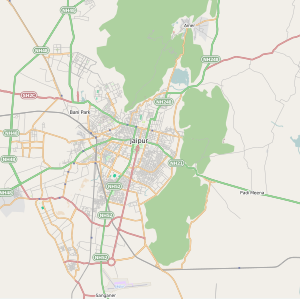
Back حصن عامر Arabic Крэпасць Амбер Byelorussian Ambér (pevnost) Czech Fort Amber German Fuerte Amber Spanish Amber gotorlekua Basque دژ آمیر Persian Fort d'Amber French આમેરનો કિલ્લો Gujarati מבצר אמבר HE
| Amer fort | |
|---|---|
| Part of Rajasthan | |
| Amer, Rajasthan, India | |
 | |
| Coordinates | 26°59′09″N 75°51′03″E / 26.9859°N 75.8507°E |
| Type | Fort and Palace |
| Site information | |
| Controlled by | Government of Rajasthan |
| Open to the public | Yes |
| Condition | Good |
| Site history | |
| Built | 1592[1] |
| Built by | Man Singh I |
| Materials | Sandstone and marble |
| Type | Cultural |
| Criteria | ii, iii |
| Designated | 2013 (37th session) |
| Part of | Hill Forts of Rajasthan |
| Reference no. | 247 |
| Region | South Asia |
Amer Fort or Amber Fort is a fort located in Amer, Rajasthan, India. Amer is a town with an area of 4 square kilometres (1.5 sq mi)[2] located 11 kilometres (6.8 mi) from Jaipur, the capital of Rajasthan. Located high on a hill, it is the principal tourist attraction in Jaipur.[3][4] Amer Fort is known for its artistic style elements. With its large ramparts and series of gates and cobbled paths, the fort overlooks Maota Lake,[4][5][6][7] which is the main source of water for the Amer Palace.
Amer Palace is great example of Rajput architecture. Some of its buildings and work have influence of Mughal architecture.[8][9][10] Constructed of red sandstone and marble, the attractive, opulent palace is laid out on four levels, each with a courtyard. It consists of the Diwan-e-Aam, or "Hall of Public Audience", the Diwan-e-Khas, or "Hall of Private Audience", the Sheesh Mahal (mirror palace), or Jai Mandir, and the Sukh Niwas where a cool climate is artificially created by winds that blow over a water cascade within the palace. Hence, the Amer Fort is also popularly known as the Amer Palace.[5] The palace was the residence of the Rajput Maharajas and their families. At the entrance to the palace near the fort's Ganesh Gate, there is a temple dedicated to Shila Devi, a Goddess of the Chaitanya cult, which was given to Raja Man Singh when he defeated the Raja of Jessore, Bengal in 1604. (Jessore is now in Bangladesh).[4][11][12] Raja Man Singh had 12 queens so he made 12 rooms, one for each Queen. Each room had a staircase connected to the King’s room but the Queens were not to go upstairs. Raja Jai Singh had only one queen so he built one room equal to three old queen’s rooms.
This palace, along with Jaigarh Fort, is located immediately above on the Cheel ka Teela (Hill of Eagles) of the same Aravalli range of hills. The palace and Jaigarh Fort are considered one complex, as the two are connected by a subterranean passage. This passage was meant as an escape route in times of war to enable the royal family members and others in the Amer Fort[13] to shift to the more redoubtable Jaigarh Fort.[5][14][15] Annual tourist visitation to the Amer Palace was reported by the Superintendent of the Department of Archaeology and Museums as 5000 visitors a day, with 1.4 million visitors during 2007.[2] At the 37th session of the World Heritage Committee held in Phnom Penh, Cambodia, in 2013, Amer Fort, along with five other forts of Rajasthan, was declared a UNESCO World Heritage Site as part of the group Hill Forts of Rajasthan.[16]
- ^ "Outlook". Outlook. December 2008.
- ^ a b Outlook Publishing (2008). Outlook. Outlook Publishing. p. 39.
- ^ Mancini, Marc (2009). Selling Destinations: Geography for the Travel Professional. Cengage Learning. p. 539. ISBN 978-1-4283-2142-7.
- ^ a b c Abram, David (2003). Rough guide to India. Rough Guides. p. 161. ISBN 978-1-84353-089-3.
- ^ a b c Pippa de Bruyn; Keith Bain; David Allardice; Shonar Joshi (2010). Frommer's India. Frommer's. pp. 521–522. ISBN 978-0-470-55610-8.
- ^ "Amer Fort - Jaipur". Retrieved 17 November 2017.
- ^ "Maota Sarover -Amer-jaipur". Agam pareek. Retrieved 25 September 2015.
- ^ "Amer | India". Encyclopedia Britannica. Retrieved 21 June 2019.
- ^ DK (2 November 2009). Great Monuments of India. Dorling Kindersley Limited. ISBN 9781405347822.
- ^ Bhargava, Visheshwar Sarup (1979). Rise of the Kachhawas in Dhundhār (Jaipur): From the Earliest Times to the Death of Sawai Jai Singh (1743 A.D.). Shabd Sanchar.
- ^ Rajiva Nain Prasad (1966). Raja Mān Singh of Amer. World Press. ISBN 9780842614733.
- ^ Lawrence A. Babb (2004). Alchemies of violence: myths of identity and the life of trade in western India. SAGE. pp. 230–231. ISBN 978-0-7619-3223-9.
- ^ "Glorious Amber Fort Breath Taking Place To Visit In Jaipur 2020". Fort Trek. 9 September 2020. Retrieved 20 September 2020.
- ^ "Jaipur". Jaipur.org.uk. Retrieved 16 April 2011.
- ^ D. Fairchild Ruggles (2008). Islamic gardens and landscapes. University of Pennsylvania Press. pp. 205–206. ISBN 978-0-8122-4025-2.
- ^ Singh, Mahim Pratap (22 June 2013). "Unesco declares 6 Rajasthan forts World Heritage Sites". The Hindu. Retrieved 1 April 2015.
© MMXXIII Rich X Search. We shall prevail. All rights reserved. Rich X Search

